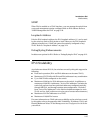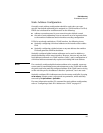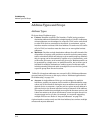
3-4
IPv6 Addressing
IPv6 Address Structure and Format
An IPv6 address includes a network prefix and an interface identifier.
Network Prefix
The network prefix (high-order bits) in an IPv6 address begins with a well-
known, fixed prefix for defining the address type. Some examples of well-
known, fixed prefixes are:
2000::/3global (routable) unicast address
fd08::/8 unique local unicast address
fe80::/8link-local unicast address
ff00::/8multicast address
The remainder of the network prefix depends on the prefix type, and includes
information such as the subnet destination of unicast addresses or the flags
and scope of multicast addresses.
In a given address, CIDR-type notation (Classless Inter-Domain Routing) is
used to define the network prefix. In the following address example, the 64
bits comprising 2001:0db8:0260:0201 form the network prefix:
2001:0db8:0260:0212:0215:60ff:fe7a:adc0/64
A shorter way to show this address is to remove the leading zeros:
2001:db8:260:212:215:60ff:fe7a:adc0/64
Interface (Device) Identifier
The remaining (low-order) bits in the address comprise a unique interface
identifier in an IPv6 address. In the above example, the rightmost 64 bits
(215:60ff:fe7a:adc0) comprise the interface identifier. Unlike IPv4, an IPv6
identifier for a unicast or anycast address can be automatically generated from
the switch's MAC address using EUI-64 (Extended Unique Identifier) format.
Other methods include DHCPv6 assignments and static configuration. Inter-
face identifiers are covered in more detail in the later sections of this chapter
describing different address types.


















